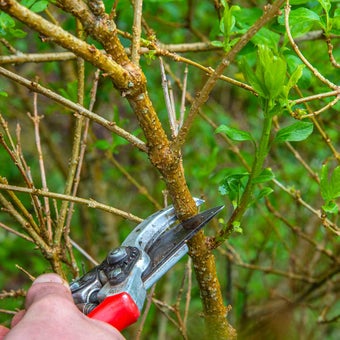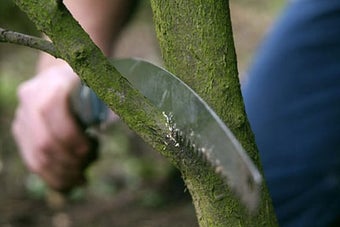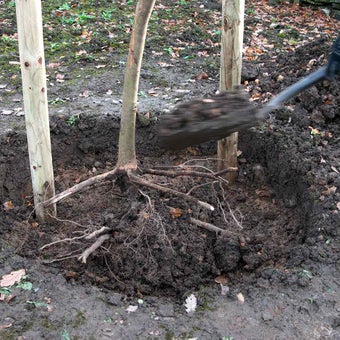
Quick facts
Suitable for - Evergreen and deciduous trees and shrubs
Timing - Deciduous during dormancy; evergreens October or late March
Difficulty - Easy to difficult
Suitable for...
Established trees and shrubs should be only moved if necessary as even with the best care the tree or shrub may fail to thrive or even die. Renovation may be an alternative.
Plants resenting root disturbance such as Rosa, Magnolia, Cytisus and Cistus can be tricky to move.
Young plants transplant fairly well, but more established specimens will suffer greater stress and require advanced preparation. As a rule-of-thumb, plants that have been growing in position for more than five years are much less likely to survive transplanting than younger specimens.
Consider using a specialist contractor to move mature plants or a large number of trees.
Timing
The optimum time to move established trees or shrubs depends on their type;
- plants: Move at any time during the season from late October to mid-March
- Evergreens plants: Best moved during October or late March when the soil is beginning to warm up. This allows the roots to re-establish themselves quickly
Choose a calm, dull day to help prevent roots from drying out.
How to move trees and shrubs
Preparation
If possible prepare mature specimens a year in advance as follows:
- During November to February when dig a circular trench one spade spit, 30cm (1ft) wide, parallel with the branch spread
- Back fill the trench with to encourage fibrous, feeding root growth which will help the plant to re-establish quickly
- Thin the growth lightly by pruning out any old, worn-out wood, but do not prune hard. Where necessary, re-shaping can be done once the plant is well re-established
Lifting and moving
- Water the soil well the day before moving
- Determine the extent of the root spread by exploratory digging. The main area covered by feeding roots is usually along the spread of the branches. Larger specimens may have root masses of 90-1.2m (3-4ft) or more in diameter and 40-45cm (16-18in) or more in depth
- Loosely tie in branches before lifting. Lift the plant with as much intact as possible. Some thicker roots may need to be severed cleanly with a sharp knife or secateurs
- Place on a piece of damp sacking or similar material for transporting and keep the roots covered to avoid drying out by wind or sun. Where possible, lift and replant in one operation
If replanting cannot take place immediately, pack the rootball with organic matter and wrap it in sacking, before placing it in a cool, shaded spot. Keep the plant well watered.
Replanting
- Before moving, make sure you have prepared the new spot in advance. Mark out the estimated spread of roots, adding an extra 30-60cm (1-2ft). Excavate to at least 30cm (1ft) and fork over the base and sides. On poor sandy soils mix some leafmould or garden with the soil to be used to back fill
- Place the plant in the hole, checking that the roots can be spread out fully. Where necessary, adjust the size of the planting hole
- Use the old soil-mark on the stem of the plant as a guide to the correct new planting depth. This will prevent replanting too deeply (one of the biggest killers of all plants). Equally, planting with upper roots exposed will damage most plants
- Firm around the plant carefully to eliminate air pockets as you fill in the planting hole. Larger plants and those placed in windy sites may require staking or guying for year or two after planting until re-established to prevent wind rock
Aftercare
Moving a tree or shrub is very stressful for the plant, so for the year after moving take particular care of the following:
- Ensure that plants are watered in thoroughly after planting and during dry spells
- A thick of organic matter such as chipped or garden will help conserve moisture and suppress weeds. Keep the base of the plant free from mulch
- Evergreens may need watering even during winter months when newly planted, but avoid applying water in frosty weather
- In spring, as growth begins, apply a general fertiliser
Problems
Too much or too little water may hinder re-establishment as will the loss of too many roots during transplanting or planting too deeply.









